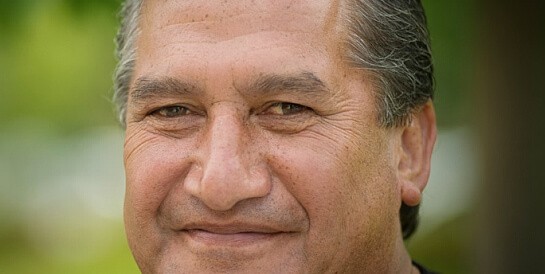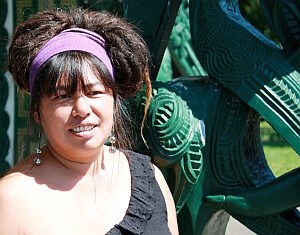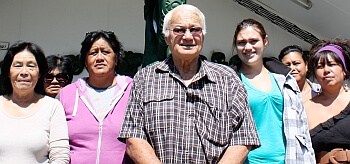The two burning issues before Hawke’s Bay at the moment, amalgamation and the dam, bring into focus the role of Māori leadership in the debate. Both initiatives have been Pākehā-driven; yet both hold significant implications for Māori. So, how is the Māori voice, given unique status by our governing Treaty, expressed in decision-making? And where does local Māori leadership authority or legitimacy come from?
Mark Sweet’s article, which follows, indicates just how complicated the ‘Māori Organisation Chart’ might be, as illustrated by the consultation process conducted (or not) around the Regional Council’s plans for the Tukituki catchment. With amalgamation it is the same, with individual councils advancing positions that might or might not reflect advice taken from Māori leaders, or from some Māori entities and not others. And of course Māori groups can submit directly to the Local Government Commission, as Ngāti Kahungunu plans to do, in their case supporting amalgamation.
Ngahiwi Tomoana, chairman of Ngāti Kahungunu Iwi Inc (NKII), the most inclusive Māori grouping in the region, suggests the claim that Māori leadership structure is ‘too complicated’ can be easily turned on its head. He notes that Māori leaders in Hawke’s Bay alone must deal with five councils, who constantly squabble amongst themselves, as well as numerous central government agencies. Throughout its rohe, NKII deals with 11 councils.
Tomoana is perhaps the single most visible of Māori leaders in the region. He is elected via a multi-level process that begins at the whānau and marae level, progressing through six taiwhenua, then ultimately a membership vote for the chairman position. He also chairs NZ’s Māori Economic Development Advisory Board and the NZ China Council, and serves on numerous local boards, including the DHB.
Given Tomoana’s local and national visibility, most ‘consultation’ processes in the region seek to involve him and to tick the NKII box, often as a ‘short-cut’ for councils to avoid broader engagement.
Excepting Central Hawke’s Bay, each of the councils has a self-appointed Māori advisory committee of some sort. Some argue these are relatively passive, rarely posing a challenge to council staffs who ‘manage’ them well and consult superficially.
Another Māori voice is expressed at the grassroots level via the marae. The Hastings marae have organized themselves as Ngā Marae, led by Tama Huata and Des Ratima. Some marae take an active role in matters that most directly affect them (e.g., Kohupatiki Marae’s focus on cleaning up the Karamu Stream); others less so. None are swimming in resources to engage in local government decision-making.
A new ‘face’ in decision-making is the Regional Planning Committee (RPC) associated with the Regional Council. As Mark explains more fully, this group has been instigated by the Crown in the course of Treaty settlements and consists equally of regional councillors and representatives of Tangata Whenua – specifically the nine Treaty claimant groups in Hawke’s Bay. Co-chaired (with Fenton Wilson) by Toro Waaka representing Ngāti Pahuawere Development and Tiaki Trusts, the RPC must be given a direct voice in all natural resource planning in the region.
And finally are the few Māori who have stood successfully for direct election to local government – Henare O’Keefe, Jacoby Poulain and Denise Eaglesome being the most visible.
Legitimate voices, one and all, at this stage with various degrees of experience at engaging in local government decision-making and politics. Add elders with kaumātua status and those with topical expertise (e.g., Morry Black on RMA issues, or Tracey Te Huia on Māori health) and one begins to get the picture of Hawke’s Bay’s Māori leadership.
Ngahiwi Tomoana views the present situation as “evolutionary”, with hapū-based organisations, using resources gained by Treaty settlements, building the knowledge base and fresh leadership to resolve local issues and pursue economic development, while NKII then “stops kicking at everything that moves” and focuses on region-wide matters.
With this current complexity in mind, consider Mark’s report on Māori consultation on the Tukituki.
Divide to Rule?
First came the lawyers and the expert witnesses for Hawke’s Bay Regional Council (HBRC), and their Investment Company (HBRIC). Eight days of detail on Plan Change 6 and the Ruataniwha Dam, which form the basis of the Tukituki Catchment Proposal.
In the Municipal Theatre in Hastings, the Board of Inquiry (BOI) sat and listened, and asked questions, and they didn’t mix with the crowd. They took refreshments alone, and used facilities reserved only for them.
Next came the corporates, like Fonterra and Mr Apple, and the government departments, and the non-government organisations (NGO’s) like Fish and Game and the Environmental Defence Society. Then individuals, acting alone, began to appear.
On the 19th day of the Inquiry the first submission from a Māori organisation was presented. Tamatea taiwhenua, the tribe whose ancestral lands include the site of the proposed Ruataniwha Dam, made their case for being the primary consultative partner with HBRC, and enthusiastically endorsed the plan and the dam.
Consultation with Māori is a requirement of the Resource Management Act (RMA) when local authorities are processing plan changes. It is a Treaty of Waitangi obligation, under Article 2, in the partnership agreement between Māori and the Crown.
By day 24 the inquiry should have finished. That was the plan. But an extension was required, and everyone went home for Christmas.
Last but not least
The hearings resumed on the 15th of January on Matahiwi Marae. The Board members were welcomed as equals along with all the other guests, and everyone lunched together, and used the same facilities.
First up was legal counsel for Ngāti Kahungunu Iwi Incorporated (NKII), Te Taiwhenua o Heretaunga, and six marae, collectively known as the Heretaunga Parties. The Board was told that, NKII supported and represented, “the collective issues of the six taiwhenua in the Ngāti Kahungunu Iwi rohe: Wairoa, Whanganui a Orotu, Heretaunga, Tamatea, Tamaki Nui-a-Rua, and Wairarapa”.
NKKI’s lawyer then said, “The Hawke’s Bay Regional Council did not seek to engage with any representatives from NKII for the purposes of Plan Change 6.” He said the same of Taiwhenua Heretaunga, and one by one he introduced the marae – Matahiwi, Waimarama, Kohupatiki, Waipatu, Ruahapia – and he ended with the same words, “HBRC did not seek to engage with any representatives from … for the purposes of Plan Change 6.”
Over two days, the Heretaunga Parties presented their case for opposing Plan Change 6 and the Ruataniwha dam, and for the first time the Board stayed late into the night to hear cross-examination of their case. Proceedings ended at 10.55pm.
Consultation was only one aspect of why NKKI and the Heretaunga Parties oppose Plan Change 6. They also challenge the untested TRIM model of nutrient management developed for the Regional Council, and deem there is insufficient evidence to show that Tukituki water quality and ecosystems will be enhanced and protected.
For the last three days of submissions, the inquiry moved to the Municipal Theatre in Waipawa, and the members of the Board once again took their refreshments alone, and used facilities reserved only for them.
Day 29 and the marathon inquiry was winding up. The last item to appear before the Board, 40 minutes before the close, was a Memorandum of Understanding signed by HBRC, NKII, Tamatea Taiwhenua, and Heretaunga Taiwhenua.
From the Memorandum: “All parties agree that a constructive and enduring relationship between all parties is important. HBRC is committed to engaging in a meaningful manner with NKII and the Heretaunga Parties. HBRC acknowledges and agrees that re-engaging with NKII and the Heretaunga Parties will require kanohi-ki-te-kanohi, pokohiwi-ki-te pokohiwi (face-to-face, shoulder-to-shoulder) engagement at the governance level of HBRC with NKII and the Heretaunga Parties as well as at hui and hapü and marae level.”
Consultation with Māori has become a major issue for HBRC, and could delay their plans. Such is their confidence in Plan Change 6 being endorsed, and the dam approved, that construction is scheduled to begin this December.
If NKII, or any other party, appeals to the High Court for a judicial review, the delays will be costly to HBRC, with the added loss of political capital for the Government in election year.
After all, the Ruataniwha dam is the first project off the blocks in the Government’s water storage policy. They’ve already put up $6.4 million to develop the Ruataniwha scheme, and a share of the $400 million earmarked for water storage will go the toward construction. Labour and Greens oppose the dam. It is an election issue.
Back to the beginning
To understand how HBRC went about its consultation process, I ask acting CEO, Liz Lambert, to start at the beginning.
“Councils tend to rely on a national-based directory that’s provided electronically on TPK on who to consult with [TPK is Te Puni Kōkiri, the government department in charge of Māori affairs] and back in 2005 there are emails [from NKII] which make it quite specific that in matters of resource management consultation we were to go through their taiwhenua.”
The web-site showed Tamatea as the taiwhenua of the dam site and the Tukituki River until south of Waipawa, after which, and all the way to the sea, the Tukituki flows through the taiwhenua of Heretaunga.
That HBRC chose to consult with Tamatea at the exclusion of Heretaunga seems a serious lapse in judgement.
“We have been to every Tamatea marae affected by Plan Change 6 and the dam, but I admit we haven’t been to every marae on the lower Tukituki,” says Lambert.
However, she is adamant NKII was informed from the outset. “We followed the process NKII had put in place back in 2005,” says Liz. “They’ve changed their process and we’re happy to accommodate that.” And … “If they want to take a more active roll in the Plan Change development process, as the authority, we’re happy with that.”
But how did NKII get themselves into the position they’re in? Lambert replies, “NKII are in a difficult position because the Tukituki Catchment Proposal covers three of their taiwhenua – Tamatea, Heretaunga, and Tamaki nua-a-Rua. NKII appear to have come in on the side of Heretaunga and don’t appear to be supporting the other two taiwhenua as much. Perhaps NKII have felt uncertain about their mandate to speak until now.”
Asked if a “colonial attitude of divide and rule might apply here,” Lambert shook her head, and replied, “I can’t comment on that.”
To be fair, Lambert wasn’t the CEO when the decisions on consultation were hatched. Most of the credit for Plan Change 6 and the dam, and the strategy to achieve success, goes to Andrew Newman, past CEO of HBRC, now CEO of HBRIC, the investment company, and the man in charge of delivering the dam.
Divide and rule
‘Divide et Imperia’ was devised by the Roman Empire to control conquered territories. The concept refers to a strategy that breaks up existing power structures by driving wedges between the groups that were formally cohesive and linked. It includes conferring special privileges on those chosen to co-operate, causing divisiveness and conflict, with those excluded.
At the head waters of the Tukituki river, Taiwhenua Tamatea have signed an agreement with HBRIC to set up a trust which will oversee certain aspects of the dam construction, and monitor the Tukituki, once it is operational. The budget is $8.9 million.
At the river’s mouth, the hapū of Matahiwi Marae tell a very different story.
Tom Mulligan, chairman of the Marae Committee says, “In the past we’ve been asked our opinion, but with Plan Change 6 and the Ruataniwha Dam proposal, we were not involved in any consultation.” Tom invites as many people as he can muster to be part of the BayBuzz interview, and everyone nods in agreement when he says, “What really bugs us is that Tamatea through the Regional Council have the audacity to recognise themselves as the mana whenua (people) of the river, because we believe that wherever the river flows, the people on its bank are mana whenua.”
I ask the group if they think HBRC has employed the ‘divide to rule’ strategy, and one participant Donna Kingi, is certain they did. “There seems a clear intention not to consult with us,” Donna says. “It feels familiar. Isn’t it what happened with the Treaty of Waitangi? If their intentions were honorable, then the systems should be very clear, but when the intentions aren’t honorable, everything’s confused.”
It seems implausible HBRC would have the oversight not to include consultation with Matahiwi Marae, so I ask Tom again, “Are you saying nobody came to talk to you?”
“Well,” Tom says, “Mike Mohi came to my house one day and said he wanted to talk to me about the dam, so I invited him to one of our monthly marae meetings. He came with Roger Maaka but they did not talk about Plan Change 6. They said that going to a Māori Committee was the best way to get the message across about the dam. That was it. They talked for no more than ten minutes.”
“And they call that consultation,” someone in the group calls out.
This view is echoed by NKII chairman Ngahiwi Tomoana, who refers derisively to “cup of coffee consultation” and insists that NKII had never been properly engaged. “I’ll defend that to anyone,” he says. “I’m quite fluent on the processes of local government.” He notes that its experience and expert staff make NKII “hard Māori to deal with, and so the Regional Council avoids us. They prefer to go to soft Māori … people with a lot less knowledge, resource and investigative ability.” As he sees it, “The Regional Council has been going around looking for a ‘Yes’.”
Mike Mohi has been the Māori advisor to HBRC for the past 12 years. He chairs the Māori Committee, which was HBRC’s main vehicle for consultation over Plan Change 6. Sitting on the committee for the entire Plan Change process was Liz Remmerswaal, and she’s adamant the Māori Committee was not a forum for consultation. “Reports would be presented, but there wasn’t much discussion or feedback, and lot of people weren’t happy with the process.”
Roger Maaka is the voice of Tamatea on the subject of the Ruataniwha dam. He was involved from the outset, serving on HBRIC’s senior stakeholder group for the project. From his position as Head of Māori Studies at the EIT, he mentored Benita Wakefield, author of a cultural assessment, which advised HBRC how Māori values might be respected and managed in the Plan Change.
NKII’s role
Under cross-examination at the BOI, Benita Wakefield recognised the tension between Tamatea and NKII, when she told the Board that some people see, “… this dam is going to be the ruin of the iwi. It’s going to bring down the iwi. You know,” she said, “it has never been my intention to be party to anything that is going to interfere with the mana of our iwi.”
At the inquiry, Tamatea Taiwhenua claimed their right to act on their own behalf, and manage the benefits flowing from the dam’s construction. Heretaunga Taiwhenua and NKII challenged that stance, and NKII changed the TPK website as to who should be consulted on plan changes from taiwhenua to iwi.
Adding to the confusion over consultation is the parallel development of Plan Change 6 with the dam project.
As Liz Lambert points out, “Under the RMA consultation is not required for resource consent applications [e.g., for the dam], but having said that HBRIC did have extensive consultation, particularly through the Mana Whenua Working Party.”
There is a perception that this Working Party (MWWP) was a consultation vehicle for Plan Change 6. It was not. Here the roles of HBRC and HBRIC mingle without clarity; the former being responsible for the Plan Change, the latter for the dam, one requiring consultation, the other not.
Affected by the confusion is Des Ratima. He served on the MWWP as a representative of Heretaunga, and soon he found himself being singled out by HBRC. “They were saying we’ve talked to Des, so we’ve consulted with Kahungunu, … and I said [to HBRC] I have to be very clear with you, that has never been my position, and don’t recall you telling me I was being used in this way.”
The outcome for Ratima came in January, when he was told by NKII, that for the Memorandum of Understanding to proceed, they didn’t want him on any of the working groups related to the dam. “I’ve taken that back to marae and they’re not happy. It’s not for NKII to dictate to them who they want to represent them.”
He continues, “NKII never had a mandate. They were set up for fisheries settlement. They’re not a Rūnanga [traditional tribal assembly]; they’re an incorporated society. They pose as the mandated Iwi Authority, and it’s been unchallenged because that’s suited everybody, until now.”
CEO of NKII, Dr Adele Whyte, led the negotiations on the Memorandum of Understanding with HBRC. In the final draft submitted to the Board of Inquiry on 8 February, HBRC acknowledges NKII, “as the iwi authority for Ngāti Kahungunu” and both parties “have committed to entering a formal relationship accord” to better their communication and relationship in the future.
NKII chairman Tomoana interprets the memorandum as giving his organisation the opportunity to conduct a full “peer review” of the standards and methodologies embedded in Plan Change 6 as well as the case for the dam and alternatives to it.
If that does not occur and NKII is not satisfied, then “all bets are off” he told BayBuzz. “It’s not a done deal at the Board of Inquiry. We’ll challenge it to the degree we need to … legal, political, social protest … any tool at our disposal.” Asked what he meant by alternatives to the dam, Tomoana suggested significant investment in developing Māori agricultural potential in the Wairoa region.
If NKII ultimately opposes the dam, that will affect the investment in the dam that HBRIC is counting upon from Ngāi Tahu. Says Tomoana, “If the dam does not meet the environmental standards of our iwi, then they will review the investment.”
Des Ratima is not surprised NKII is asserting their authority so firmly. “What they’re trying to develop is a mandated Iwi Authority, but the thing that’s going to undo them is that each hapū are doing their own treaty settlements, and they’ve already been told by Pahauwera (Wairoa) to get out the way, and I wouldn’t be surprised if the others (claimants) say the same thing.”
Treaty settlements are well advanced in Hawke’s Bay and cited to be worth $200 to $400 million. Settlements will also confer kaitiaka on claimants – that is, guardianship of river catchments, forests, and tidal ecosystems, as has happened with the Ahuriri settlement.
Responsibility for the key resource management decisions for Hawke’s Bay lies with the Regional Planning Committee (RPC) set up by HBRC in 2011. This implements a model advanced by the Crown in its negotiations with Treaty claimants, and is expected to be codified in legislation.
Sitting on the RPC in equal numbers are councillors and representatives from the Treaty claimant groups. NKII does not have a seat at the table, because the RPC was established as a Treaty of Waitangi redress for the Tangata Whenua Groups [Treaty claimant families], not the Iwi Authority.
Where NKII’s input would be invaluable is as independent scrutiniser in the submissions phase of developing the key resource management planning policies for Hawke’s Bay – the Regional Policy Statement, the Regional Resource Management Plan, and the Regional Coastal Environment Plan.
Access to expert advice – economic, scientific, cultural – within a Māori framework, is something NKII currently provides, and its corporate structure is similar to Ngāi Tahu and Tainui, who have managed their Treaty settlements into billion dollar portfolios. NKII is well positioned to serve in that role, but to remain relevant, it needs united support from its people, as well as recognition as leader of Kahungunu aspirations at the governance level.
I ask Tom Mulligan from Matahiwi Marae what he thinks will happen in the future, and Tom says, “We’re not going to fight among ourselves. We must work together. And a good example was here during the hearings when we catered for 120 people on the first day. In the kitchen were representatives from all the maraes, we were Kahungunu all working for a purpose. We must unite, and work together, to overcome our problems.”
And Tom thinks the chairman of the Board of Inquiry got the message about the Māori way in consultation. “He asked me to call him Lester,” Tom says, “and he insisted we all eat together, and he insisted we all use the same facilities; that we do everything together. That’s our way, kanohi-ki-te-kanohi, pokohiwi-ki-te pokohiwi (face-to-face, shoulder-to-shoulder).”
And as surely as ‘divide and rule’ is a strategy to maintain power through division, ‘united we stand’ is the way to defeat it through solidarity and cooperation.






